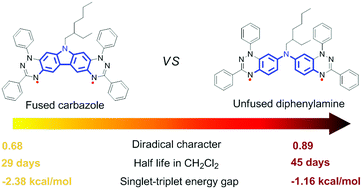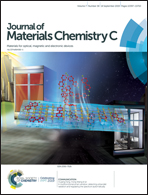Nitrogen-coupled blatter diradicals: the fused versus unfused bridges†
Abstract
We report the synthesis and characterization of nitrogen-coupled diradicals NDR (unfused) and CDR (fused). NDR has a large diradical character y of 0.89, and a small singlet–triplet energy gap ΔES–T of −1.16 kcal mol−1 with the observation of a forbidden transition signal (Δms = ±2). Moreover, NDR shows very high stability. In contrast, the fused CDR has a smaller y (0.68), along with a larger ΔES–T (−2.38 kcal mol−1).



 Please wait while we load your content...
Please wait while we load your content...